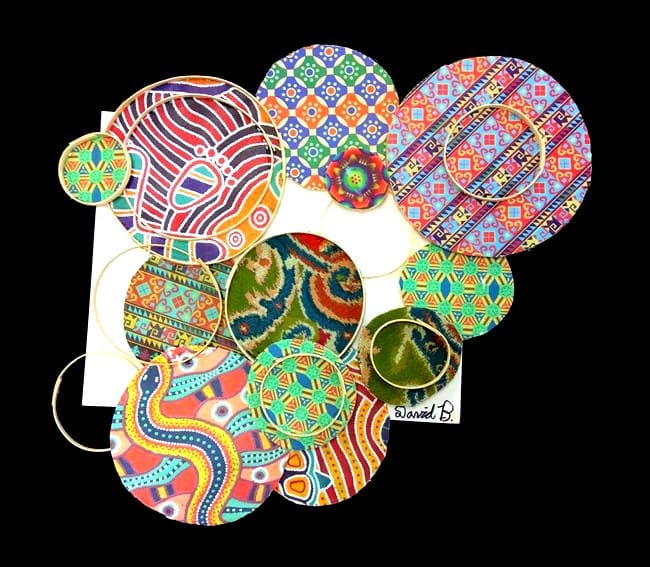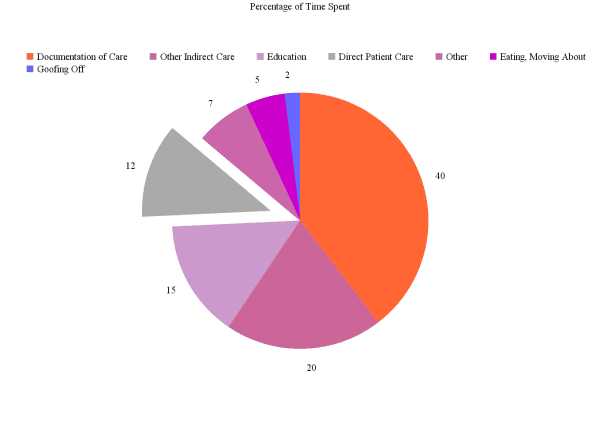How Did Ancient Artists Draw Circles
Gina has been an art teacher for 20+ years. She's taught in the judicial organization and in community art programs also as in schools.

An art consignment created past i of my onetime students, David
Gina Hulse
History of the Circle
The word "circle" derives from the Greek kirkos, "a circle," from the base of operations ker- which ways to turn or bend. The origins of the words "circus" and "circuit" are closely related.
The circle has been known since before the starting time of recorded history, and has had a distinguished part in the art and written linguistic communication of every culture since the offset of mankind, symbolizing:
- infinity
- perfection
- unity
- completeness
Natural circles would have been observed, such as:
- the Moon
- the Lord's day
- the track on sand of a found stalk blowing in the wind
The circle is the basis for the wheel, which, with related inventions such as gears, makes much of mod civilisation possible.
In mathematics, the report of the circle has helped inspire the development of geometry, astronomy, and calculus.
Representations of the Circumvolve

The halo used in spiritual figures

The modern solar day pie nautical chart

Circular gauges in automobiles
Our Fascination With the Circle
It seems that even thousands of years after Egyptians first approximated the value of pi, the intrigue of circles lives on.
We humans are drawn to circles, and have been since prehistoric days:
- Prehistoric gathering places in the round
- Hindu mandalas
- Halos that float over the heads of saints
- Modern pie charts
- Circular gauges—the darlings of dashboards
- A labyrinth, in Ancient Greece
- Rose window
- Yin-yang symbol in China
- Zodiac in Mayan culture
- The four elements in Native American symbolism
- the sun, or the moon
- The Olympic logo — the 5 circles represent five continents harmoniously joined and perfectly balanced.
Cheque out these logos that utilize the circle. Astonishing, aren't they?
We merely detect circles naturally satisfying.
Scroll to Continue
Read More From Owlcation

Hindu mandalas

The circle was the basis for the wheel.

The yin-yang symbol from China

The medicine wheel in Shamanism

The Mayan Zodiac
The Unity Consignment: Create a Work of Fine art Using the Circle as Your Inspiration
Only every bit a circle describes a country of unity and completeness, there are principles that can be relied upon to produce integrality in the varied elements of visual art.
A simple grouping of rings and circles demonstrates how these principles work together to make a harmonious depression-relief sculpture:
- The balance of an asymmetrical composition, organized then the circles overlap and join with each other
- The colors, textures, and designs that place emphasis on a function or parts of the sculpture
- The repetition of patterns in the paper and circles that produce an organized visual rhythm
- The variety of shapes and sizes, all circular, that guide the viewer through and effectually the sculpture, creating move and unity that make the art consummate and compelling
Examples of the Completed Unity Assignment

This student used the circle idea to create a bear pattern.

This pupil adult her initial every bit the final work.

This pupil decided to do a free-class sculpture.
Materials Used for This Assignment
- Natural reed for basketmaking, 3/eight" apartment, 175-ft. coil
- Assorted colored papers, viii-1/2" x eleven"
- Scissors
- Carpenter's forest glue
- Schoolhouse mucilage
- Large wooden leap clothespins
Instructions for the Assignment
Using flat natural reeds and assorted papers, students start create rings in a variety of sizes, then assemble their sculptures by gluing and creating small "slots" to fit the rings together.
Preparation
- Cut dry out reeds into assorted lengths.
- TIP: Soak the reeds in h2o start to brand them easier to bend.
Procedure
- Overlap the ends and bring together them with a strong glue.
- Hold the ends in place with a prune or clothespin until the glue is completely fix, then remove.
- They tin be glued when dried or tied together with yarn as students chose.
- The reed circles may be painted with acrylic colors, or left natural.
- Select papers, choosing harmonious colors and patterns.
- Place white mucilage on the top side of a ring, then turn the ring over and place it glue-side-down on a piece of newspaper. Repeat with more than rings, just exit some of the rings uncovered.
- When the gum is dry out, trim the paper along the edge of the band.
- Assemble the sculpture. For best results, plan the arrangement of the rings before gluing. Some rings may be layered over paper-covered rings and glued direct to them. Others can be joined reed to reed past creating pocket-sized "snips" with scissors. Make small-scale cuts with pointed pair of scissors, no more than half the width of the reed. Create matching cuts where the next band will align. Place a drop of glue into the cuts and fit the rings together.
Options: Cover the rings with fabric, burlap, photos, wire mesh, or recycled cards. Or paint and assemble the rings without whatever roofing.
Some of the About Famous and Mysterious Circles in History
Circles are all around united states every mean solar day. But how ofttimes practise you notice them? Circles take fascinated people throughout the ages, so let's explore some of the most famous and mysterious circles in history.
Occurring either by happenstance or designed to pay homage to the shape that the Greek scholar Proclus chosen "the outset, simplest and nigh perfect form," these sites highlight the singular symmetry and symbolism the circumvolve embodies.
Stonehenge

Beginning as early as 3300 B.C. standing stones, often in the form of a circle or flattened oval, began to be erected around the British Isles. At least 900 of them however exist, though many more than must take been destroyed in the march of 'progress.'
You lot have probably heard of the most famous, though not the most moving or impressive, stone circle at Stonehenge in Wiltshire, England. These sites were extremely spiritual, and it has too been suggested that Stonehenge was arranged as a sort of astronomical observatory then that the lord's day would rising in line with i of the stones on the day of the summer solstice, the longest day of the year.
A lot of pretty outrageous claims have been fabricated for the purpose of these circles, ranging from UFO landing pads to observatories for a highly evolved form of astronomer priests. The truth is probably a lot more mundane; most would have been an evolved form of the earlier henges and causewayed camps, functioning equally multi-purpose tribal gathering places for ritual observances having to do with the seasons and the fertility of the globe.
Other stone circumvolve sites worth mentioning include:
- the about visitable stone circles at Avebury, in Wiltshire
- Castlerigg in Cumbria
- the Rollright Stones in Oxfordshire
Ingather Circles
One type of circumvolve that still fascinates people today is the crop circumvolve. In recent times they take been the discipline of conspiracy theories and hoax pranks, merely there were reports of them in ancient times too, every bit they were believed to exist works of the devil, as mentioned in the video. Nobody really knows how these complicated patterns are formed.
The Circumvolve in Ancient Hellenic republic

Ancient Greek theater (50); Greek primal circle design (r)
In Aboriginal Greek civilisation the circle was thought of equally the perfect shape. Can you think why? How many lines of symmetry does a circle have, for instance? To the Greeks the circumvolve was a symbol of the divine symmetry and balance in nature. Greek mathematicians were fascinated past the geometry of circles and explored their properties for centuries.
Turkey
A focus on circles is axiomatic amid structures built throughout history. Although the meaning of its design is still beingness deciphered, Gobekli Tepe, a series of stone circles in Turkey, is the oldest known temple, built vi,000 years prior to Stonehenge (another famous circumvolve). The shape marks many more of import gathering places used by diverse cultures every bit centers of worship, governance and even spectacle.
Ancient Roman Architecture Using the Circle

Colosseum

The Pantheon
Modernistic Day: Olympic Circles
Circles are still symbolically important today—they are oft used to symbolize harmony and unity. For instance, take a look at the Olympic symbol. Information technology has 5 interlocking rings of different colours, which represent the five major continents of the world united together in a spirit of healthy competition.
Variations of the Olympic Rings or Circles




The Indian Parliament's Cardinal Hall Building
The blueprint of the Indian Parliament'southward Central Hall building is circular to represent the Ashoka Chakra, a Hindu symbol that literally translates to "bike of the police," which is also on the country's flag.
Flag of Bharat

The Ashoka Chakra, a Hindu symbol that literally translates to "wheel of the law," can be seen on the flag of India
Fairy Circles in Africa
Fairy circles in Africa embody a similar caste of mystery. Blank areas of earth surrounded past round rings of grass, fairy circles' origins and distribution remain unexplained, with some terming them the "footprints of the Gods."
The Circumvolve as a Symbol in Wedding Rings

Ancient Viking wedding ceremony ring

A set of simple modern day hymeneals rings
The circle is a symbol that all-time represents connectivity.
Before diamond wedding rings became popular thank you to DeBeers aggressive entrada, betrothal rings were a Roman custom. The ring, due to its circular nature, portrays the infinity of lasting dearest.
The wedding ceremony band's shape represents an unbroken promise of love and commitment. The circle has no commencement and no cease; therefore, the marriage has no end. It is believed that many past cultures shared the same beliefs near the circles.
At that place is, however, another theory backside the ring's shape. Many religions consider spousal relationship as "half of the organized religion." Some historians say that the wedding ring represents two halves meeting to form a united whole. By completing the circle, primitive man also completed his religion.
More Completed Assignments

A free-class depression-relief example. Students chose from a variety of papers that represented dissimilar cultures.

Some students too chose metallic papers.
Famous artists who loved to paint the circumvolve: Kandinsky
A study of circles would not exist consummate without taking a look at the art of Wassily Kandinsky.
The Art of Wassily Kandinsky
A Lesson Based on Wassily Kandinsky'south Concentric Circles
Just for fun......The Kandinsky Event
How Many Circular Things Can Y'all Proper name?
Apart from what I take listed here, how many other circular things can y'all name?
Take out a piece of paper and brand a list.
The circle is a very popular shape, isn't it?
© 2016 Gina Welds
goodelltonothormed.blogspot.com
Source: https://owlcation.com/humanities/Complete-Unity-An-Elements-of-Art-lesson
0 Response to "How Did Ancient Artists Draw Circles"
Postar um comentário